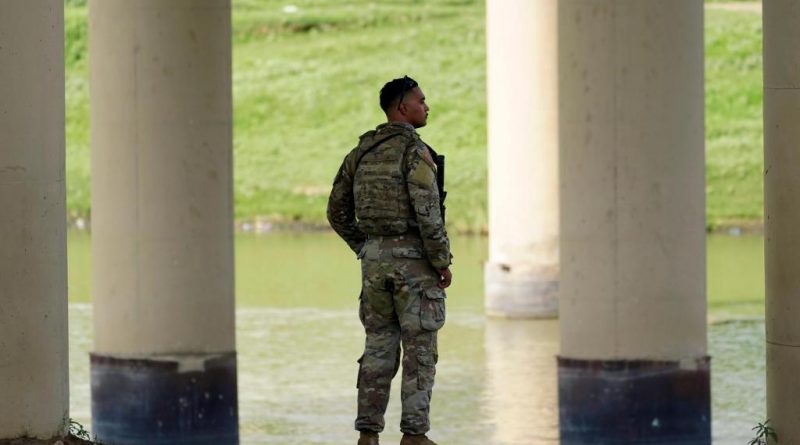Border patrol: 9 migrants die crossing swift Texas river – The Denver Post
By ELLIOT SPAGAT and SEAN MURPHY
Officials on both sides of the U.S.-Mexico border searched for more victims Saturday after at least nine migrants died while trying to cross the rain-swollen Rio Grande, a dangerous border-crossing attempt in an area where the river level had risen by more than 2 feet in a single day.
U.S. Customs and Border Protection and Mexican officials discovered the victims near Eagle Pass, Texas, on Thursday, following days of heavy rains. U.S. officials recovered six bodies, while Mexican teams recovered three, according to a CBP statement. It is one of the deadliest drownings on the U.S.-Mexico border in recent history.
The river, which was a little more than 3 feet (90 centimeters) deep at the start of the week, reached more than 5 feet (1.5 meters) on Thursday, and the water was flowing five times faster than usual, according to the National Weather Service.
The CBP said U.S. crews rescued 37 others from the river and detained 16 more, while Mexican officials took 39 migrants into custody.
CBP did not say what country or countries the migrants were from and did not provide any additional information on rescue and search operations. Local agencies in Texas that were involved have not responded to requests for information.
Among the bodies recovered from the river by Mexican authorities was a man and a pregnant woman, although their nationalities were unknown, said Francisco Contreras, a member of Civil Protection in the Mexican border state of Coahuila. No details were released about the third body found.
The Border Patrol’s Del Rio sector, which includes Eagle Pass, is fast becoming the busiest corridor for illegal crossings. Agents stopped migrants nearly 50,000 times in the sector in July, with Rio Grande Valley a distant second at about 35,000. Eagle Pass is about 140 miles (225 kilometers) southwest of San Antonio.
Chief Patrol Agent Jason Owens of the Del Rio sector said that despite dangerous currents from recent rainfall, Border Patrol agents in the sector continue to encounter groups as large as 100 or 200 people trying to cross the Rio Grande each day.
“In an effort to prevent further loss of life, we are asking everyone to please avoid crossing illegally,” Owens said in a statement.
Among the reasons the area has become popular for migrants in recent years is that it is not as strongly controlled by cartels and is perceived to be somewhat safer, said Stephanie Leutert, director of Central America and Mexico Policy Initiative at the University of Texas’ Center for International Security and Law.
“It might be a different price. It might be seen as safer. It might keep you out of cities that are notoriously dangerous,” Leutert said. “Those cities (in the Del Rio sector) definitely have had a reputation as being safer than say, Nuevo Laredo.”
The area draws migrants from dozens of countries, many of them families with young children. About six of 10 stops in the Del Rio sector in July were migrants from Venezuela, Cuba or Nicaragua. The region also has been a popular crossing point for migrants from Haiti, thousands of whom have been stuck in border towns since 2016, when the Obama administration abruptly halted a policy that initially allowed them in on humanitarian grounds.
The sector, which extends 245 miles (395 kilometers) along the Río Grande, has been especially dangerous because river currents can be deceptively fast and change quickly. Crossing the river can be challenging even for strong swimmers.
“There are places when the water levels are down where you could wade across, but when the river is up it’s extremely dangerous, especially if you’re carrying kids or trying to help someone who is not a strong swimmer,” Leutert said.
In a news release last month, CBP said it had discovered bodies of more than 200 dead migrants in the sector from October through July.
This year is on track to break last year’s record for the most deaths on the U.S.-Mexico border since 2014, when the U.N. International Organization for Migration began keeping record. The organization has tallied more than 4,000 deaths on the border since 2014, based on news reports and other sources, including 728 last year and 412 during the first seven months of this year, often from dehydration or drowning. June was the fourth-deadliest month on record, with 138 fatalities.
The Border Patrol has not released official tallies since 2020.
In June, 53 migrants were found dead or dying in a tractor-trailer on a back road in San Antonio in the deadliest documented tragedy to claim the lives of migrants smuggled across the border from Mexico.
“The whole journey speaks to the desperation of people,” Leutert said. “They know that crossing the river is dangerous. They know that hiking through ranchland is dangerous. They know that crossing Mexico as a foreigner is dangerous. But they’re willing to do this because what they’re leaving behind is, to them, a worse possibility than facing risk and trying for a better opportunity in the U.S.”
Some of the busiest crossings on the border — including Eagle Pass and Yuma, Arizona — were relatively quiet two years ago and now largely draw migrants from outside Mexico and Central America’s ‘Northern Triangle’ countries of Guatemala, Honduras and El Salvador. Mexico has agreed to take migrants from the ‘Northern Triangle’ countries, as well as its own nationals, if they are expelled from the United States under Title 42, the pandemic rule in effect since March 2020 that denies rights to seek asylum on grounds of preventing the spread of COVID-19.
People from other countries are likely to be released into the United States on humanitarian parole or with notices to appear in immigration court because the U.S. has difficulty flying them home due to costs, strained diplomatic relations or other considerations. In the Border Patrol’s Del Rio sector, which includes Eagle Pass, only one of every four stops in July were processed under the pandemic rule, compared to about half across the rest of the border, according to government figures.
Venezuelans were by far the most common nationality encountered by Border Patrol agents in the Del Rio sector in July, accounting for 14,120 of 49,563 stops, or nearly three in 10. They were followed by Cubans, who were stopped 10,275 times, and then by Mexicans, Hondurans, Nicaraguans and Colombians, in that order.
As more people crossed into South Texas in the 2010s, Brooks County became a death trap for many migrants who tried walking around a Border Patrol highway checkpoint in the town of Falfurrias, about 70 miles (110 kilometers) north of the border. Smugglers dropped them off before the checkpoint and made arrangements to pick them up on the other side, but some perished on the way from dehydration.
The Baboquivari Mountains in Arizona and ranches in Texas’ Brooks County still draw Border Patrol agents and grief-stricken families hoping to rescue migrants or, if not, find corpses, but the deceptively strong currents around the Texas towns of Eagle Pass and Del Rio have become increasingly dangerous as the area has become one of the most popular spots to enter the United States illegally.
Not all victims are migrants. In April this year, the body of a Texas guardsman was recovered from the Rio Grande. He had jumped in to try to help a migrant who was struggling in the water.
___
This story was initially published on Sept. 3. It was updated on Sept. 4 to correct the spelling of Nuevo Laredo, which had been misspelled “Nueva Laredo.”
___
Spagat reported from San Diego and Murphy reported from Oklahoma City. Associated Press writers Terry Wallace in Dallas and Fabiola Sanchez in Mexico City contributed.
Source: Read Full Article



